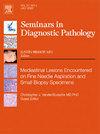NUT-rearranged sarcoma
IF 3.5
3区 医学
Q2 MEDICAL LABORATORY TECHNOLOGY
引用次数: 0
Abstract
NUT-rearranged sarcoma is an emerging group of soft tissue sarcomas defined by NUT rearrangement. It is distinct from NUT carcinoma. These sarcomas show a predilection for somatic soft tissue, the thoracic region, the gastrointestinal tract, and body cavities, and affect a wide age range. Histologically, they display one or multiple growth patterns within the tumor, including fibrosarcomatous, round cell, epithelioid/rhabdoid, and hyalinized/nested patterns. Tumor cells invariably express NUT (with the exception of tumors harboring NUTM2) and may have aberrant expression of other markers. Molecularly, NUT-rearranged sarcoma typically involves genes in the MAD transcription family. Those NUT-rearranged sarcomas seem to have distinct clinical and pathologic features. While BET inhibitors are effective in NUT carcinoma, they may not be effective in NUT-rearranged sarcoma.
NUT-rearranged肉瘤
NUT重排肉瘤是一种新兴的以NUT重排为特征的软组织肉瘤。它不同于NUT癌。这些肉瘤多发于躯体软组织、胸部、胃肠道和体腔,影响年龄范围广。组织学上,它们在肿瘤内显示一种或多种生长模式,包括纤维肉瘤、圆细胞、上皮样/横纹肌样和透明化/巢状模式。肿瘤细胞总是表达NUT(除了含有NUTM2的肿瘤),并且可能有其他标记物的异常表达。从分子上讲,nut重排肉瘤通常涉及MAD转录家族中的基因。这些nut重排肉瘤似乎具有明显的临床和病理特征。虽然BET抑制剂对NUT癌有效,但对NUT重排肉瘤可能无效。
本文章由计算机程序翻译,如有差异,请以英文原文为准。
求助全文
约1分钟内获得全文
求助全文
来源期刊
CiteScore
4.80
自引率
0.00%
发文量
69
审稿时长
71 days
期刊介绍:
Each issue of Seminars in Diagnostic Pathology offers current, authoritative reviews of topics in diagnostic anatomic pathology. The Seminars is of interest to pathologists, clinical investigators and physicians in practice.

 求助内容:
求助内容: 应助结果提醒方式:
应助结果提醒方式:


